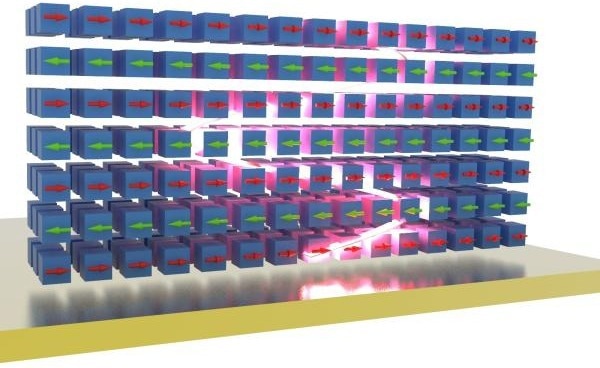New research by Vinod M. Menon and his team at The City College of New York illustrates that trapping light within magnetic materials may radically improve their inherent characteristics. Powerful optical responses of magnets are crucial for the development of magneto-optical memory devices and magnetic lasers, and for evolving quantum transduction applications.
 Light trapped inside a magnetic crystal can strongly enhance its magneto-optical interactions. Image Credit: Rezlind Bushati
Light trapped inside a magnetic crystal can strongly enhance its magneto-optical interactions. Image Credit: Rezlind Bushati
In their new article published in the journal “Nature,” Menon and his coworkers report the characteristics of a layered magnet that hordes efficiently bound excitons—quasiparticles with specifically powerful optical communications. As a result, the material has the potential of capturing light—all by itself.
As their experiments reveal, the material’s optical responses to magnetic phenomena are orders of magnitude more powerful than those in normal magnets.
Since the light bounces back and forth inside the magnet, interactions are genuinely enhanced. To give an example, when we apply an external magnetic field the near-infrared reflection of light is altered so much, the material basically changes its color. That's a pretty strong magneto-optic response.
Dr. Florian Durenberger, Study Lead Author, The City College of New York
Ordinarily, light does not respond so strongly to magnetism. This is why technological applications based on magneto-optic effects often require the implementation of sensitive optical detection schemes.
Vinod M. Menon, The City College of New York
On how the advances can be advantageous to ordinary people, Jiamin Quan, a study co-author, said: “Technological applications of magnetic materials today are mostly related to magneto-electric phenomena. Given such strong interactions between magnetism and light, we can now hope to one day create magnetic lasers and may reconsider old concepts of optically controlled magnetic memory.”
Rezlind Bushati contributed to the experimental work and was a graduate student in the Menon group.
The research done in close association with Andrea Alù and his team at CUNY Advanced Science Research Center is the consequence of a major international collaboration. Experiments done at CCNY and ASRC were complemented by measurements taken at the University of Washington in the group of Prof. Xiaodong Xu by Dr. Geoffrey Diederich. Theoretical support was offered by Dr. Akashdeep Kamra and Prof. Francisco J. Garcia-Vidal from the Universidad Autónoma de Madrid and Dr. Matthias Florian from the University of Michigan.
The materials were grown by Prof. Zdenek Sofer and Kseniia Mosina at UCT Prague and the project was supported further by Dr Julian Klein at MIT. The work at CCNY was supported via the US Air Force Office of Scientific Research, the National Science Foundation (NSF) – Division of Materials Research, the NSF CREST IDEALS Center, DARPA, and the German Research Foundation.
Journal Reference:
Dirnberger, F., et al. (2023) Magneto-optics in a van der Waals magnet tuned by self-hybridized polaritons. Nature. doi.org/10.1038/s41586-023-06275-2